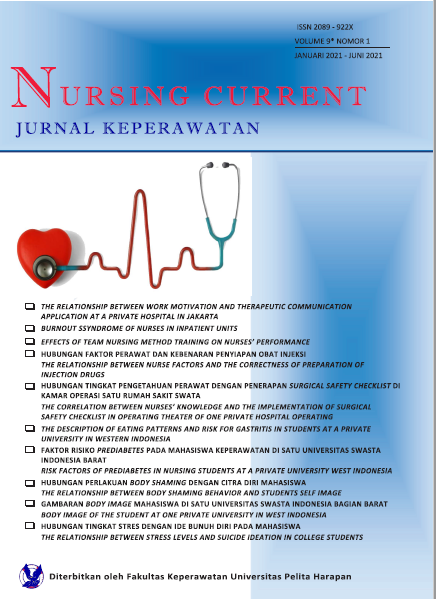FAKTOR RISIKO PREDIABETES PADA MAHASISWA KEPERAWATAN DI SATU UNIVERSITAS SWASTA INDONESIA BARAT [RISK FACTORS OF PREDIABETES IN NURSING STUDENTS AT A PRIVATE UNIVERSITY IN WEST INDONESIA]
DOI:
https://doi.org/10.19166/nc.v9i1.3460Keywords:
Prediabetes, Risk factors, StudentsAbstract
BAHASA INDONESIA Prediabetes adalah kondisi kesehatan dimana kadar gula darah lebih tinggi dari normal tetapi belum cukup tinggi untuk dikatakan diabetes. Gaya hidup dengan aktivitas fisik yang kurang (Sedentary lifestyle) memungkinkan terjadinya risiko prediabetes. Dari data awal anamnesis didapatkan 11 dari 15 (73,3%) mahasiswa jika memiliki waktu luang memilih tiduran dibandingkan berolahraga, 12 dari 15 (80%) mahasiswa lebih memilih menggunakan lift dibandingkan menggunakan tangga dalam beraktivitas, 9 dari 15 (60%) mahasiswa memilih memesan makan secara online dibandingkan berjalan untuk membeli makan di rumah makan, 4 dari 15 (26,6%) mahasiswa memiliki anggota keluarga dengan riwayat hipertensi dan diabetes. Data awal anamnesis yang didapatkan peneliti menunjukkan bahwa mahasiswa merujuk pada kehidupan sedentary lifestyle. Tujuan penelitian ini untuk mengetahui gambaran faktor risiko prediabetes pada mahasiswa keperawatan di universitas X di Indonesia barat. Penelitian ini menggunakan metode deskriptif kuantitatif dengan analisis univariat dan teknik pengambilan sampel total sampling. Sampel dalam penelitian ini berjumlah 329 orang. Hasil penelitian menunjukkan karakteristik responden seluruhnya usia <40 tahun (100%), jenis kelamin mayoritas perempuan (85%), riwayat keluarga dengan diabetes sebanyak 24%, riwayat hipertensi atau konsumsi obat anti-hipertensi 4%, indeks massa tubuh overweight 11% dan obesitas 1% dan aktivitas fisik tidak aktif 25%. Penelitian selanjutnya disarankan dilakukan pada responden dengan kelompok usia yang bervariasi, agar capaian penelitian lebih mewakili populasi
References
Adam, F. M., & Sanusi, H.(2010). Faktor Risiko Kardiovaskular pada Subyek dengan Pre- Diabetes: Kajian Indeks Massa Tubuh, Trigliserida, Kolesterol-HDL, CRP, dan Adiponektin. Scientific Journal of Pharmaceutical Development and Medical Application, 22 (4), 142-145. https://lib.atmajaya.ac.id/default.aspx?tabID=61&src=a&id=199668
Adnan, M., Mulyati, T., & Isworo, J. T. (2013). Hubungan Indeks Massa Tubuh (IMT) Dengan Kadar Gula Darah Penderita Diabetes Mellitus (DM) Tipe 2 Rawat Jalan Di RS Tugurejo Semarang. Jurnal Gizi, 2(1), 18-24. https://doi.org/10.26714/jg.2.1.2013.%25p
American Diabetes Association. (2020). Blood Sugar and Excercise.
https://www.diabetes.org/fitness/get-and-stay-fit/getting-started-safely/blood-glucoseand-exercise#:~:text=Physical activity can lower your,see the benefits of activity
Andes, L. J., Cheng, Y. J., Rolka, D. B., Gregg, E. W., & Imperatore, G. (2020). Prevalence of Prediabetes Among Adolescents and Young Adults in the United States, 2005-2016. JAMA Pediatrics, 174(2), e194498. https://doi.org/10.1001/jamapediatrics.2019.4498
Arundhana, A. I., Hadi, H., & Julia, M. (2013). Perilaku Sedentari Sebagai Faktor Risiko Kejadian Obesitas pada anak sekolah dasar di Kota Yogyakarta dan Kabupaten Bantul. Jurnal Gizi Dan Dietetik Indonesia, 12(1), 71-80. https://doi.org/10.20473/mgi.v12i1.1-6
Astuti, A. (2018). Usia, Obesitas, Aktivitas Fisik Berisiko terhadap Prediabetes. Jurnal Endurance, 4(2), 319-324. https://doi.org/10.22216/jen.v4i2.3757
Bacha, F., Lee, S., Gungor, N., & Arslanian, S. A. (2010). From pre-diabetes to type 2 diabetes in obese youth: Pathophysiological characteristics along the spectrum of glucose dysregulation. Diabetes Care, 33(10), 2225-2231. https://doi.org/10.2337/dc10-0004
Bang, H., Edwards, A. M., Bomback, A. S., Ballantyne, C. M., Brillon, D., Callahan, . . . Kern, L. M. (2009). Development and validation of patient self-assessment score for diabetes risk. Annals of Internal Medicine, 151(11), 775-783. https://doi.org/10.7326/0003-4819-151-11-200912010-00005
Cheema, A., Adeloye, D., Sidhu, S., Sridhar, D., & Chan, K.Y. (2014). Urbanization and prevalence of type 2 diabetes in Southern Asia : A systematic analysis. Journal of Global Health, 4(1), 1-20. https://doi.org/10.7189/jogh.04.010404
D’Adamo, E., & Caprio, S. (2011). Type 2 diabetes in youth: epidemiology and pathophysiology. Diabetes Care, 34(Supplement 2), S161-S165. https://doi.org/10.2337/dc11-s212
Deyasningrum, N. (2014). Faktor Dominan Terhadap Kejadian Pre Diabetes Mellitus dan Diabetes Mellitus Tipe 2 Pada Staf Kependidikan FKM UI, Depok Tahun 2014 (Thesis). Universitas Indonesia, Depok, Indonesia. http://lib.ui.ac.id/detail.jsp?id=20386407
Diabetes UK. (2010). Key statistics on diabetes. https://www.diabetes.org.uk/resources-s3/2017-11/diabetes_in_the_uk_2010.pdf
Ekaputri, M., Citrawijaya, H., Adhimulia, K. J., Sudirman, A. R., Murti, R. A., Sarena, A. P., & Purnamasari, D. (2019). Peran Riwayat Ayah Diabetes Melitus Tipe 2 pada Status Prediabetes Anak Kandung Penderita Diabetes Melitus Tipe 2. Jurnal Penyakit Dalam Indonesia, 6(4), 182-187. http://dx.doi.org/10.7454/jpdi.v6i4.339
Gupta, A.K., Brashear, M. M., & Johnson, W. D. (2011). Prediabetes and prehypertension in healthy adults are associated with low vitamin D levels. Diabetes Care, 34(3), 658-660. https://doi.org/10.2337/dc10-1829
Ghoraba, M., Shiddo, O. A., Almusimani, M., Jallad, I., Khan, A., Maranan, G., Alharbi, M. & Alsaygh, A. (2015). Prevalence of prediabetes in Family and Community Medicine Department, Security Forces Hospital, Riyadh, Saudi Arabia. International Journal of Medical Science and Public Health, 5(8), 1-8. https://doi.org/10.5455%2Fijmsph.2016.11122015277
Hutagaol, A. H., Tobing, L., & Apen, A. (2017). Karakteristik Pasien Hipertensi Dengan Prediabetes (Thesis). Universitas Jenderal Achmad Yani, Yogyakarta, Indonesia. http://repository.unjani.ac.id/repository/e6fbf32ec2f93b69de6ff254110f1565.pdf
Irawan, D. (2010). Prevalensi dan Faktor Risiko Kejadian Diabetes Melitus Tipe 2 di Daerah Ubran Indonesia (Analisa Data Sekunder Riskesdas 2007) (Master's thesis). Universitas Indonesia, Depok, Indonesia. http://lib.ui.ac.id/file?file=digital/20267101-T%2028492-Prevalensi%20dan%20faktor-full%20text.pdf
Kim, M. J., Lim, N. K., & Park, H. Y. (2015). Hypertension is an independent risk factor for type 2 diabetes: the Korean genome and epidemiology study. Hypertension Research, 38 (11), 783-789. https://doi.org/10.1038/hr.2015.72
Mandriyarini, R., Sulchan, M., & Choirun, N. (2017). Sedentary Lifestyle Sebagai Risiko Kejadian Obesitas pada Remaja SMA Stunted di Kota Semarang. Journal of Nutrition College, 6(2), 149-155. https://doi.org/10.14710/jnc.v6i2.16903
Moonesinghe, R., Beckles, G. L., Liu, T., & Khoury, M. J. (2018). The contribution of family history to the burden of diagnosed diabetes, undiagnosed diabetes, and prediabetes in the United States: analysis of the National Health and Nutrition Examination Survey, 2009-2014. Genetics In Medicine, 20(10), 1159-1166. https://doi.org/10.1038/gim.2017.238
Noventi, I., Rusdianingseh, & Khafid, M. (2020). Prevalensi, Karakteristik dan Faktor Risiko Prediabetes di Wilayah Pesisir, Pegunungan dan Perkotaan. Jurnal Ners dan Kebidanan, 6(3), 371-381. https://doi.org/10.26699/jnk.v6i3.ART.p371-381
Setyo, I., Setyoadi, & Novitasari, T. (2015). Hubungan penggunaan waktu perilaku kurang gerak (Sedentary Behaviour) Dengan Obesitas Pada Anak Usia 9-11 Tahun Di SD Negeri Beji 02 Kabupaten Tulungagung. Ilmu Keperawatan, 3(2), 155-167. https://jik.ub.ac.id/index.php/jik/article/view/44
Soewondo, P., & Pramono, L. A. (2011). Prevalence, Characteristics, and Predictors of Prediabetes in Indonesia. Department of Internal Medicine, Faculty of Medicine, Universitas Indonesia, Jakarta. Medical Journal of Indonesia, 20(4), 283-294. https://doi.org/10.13181/mji.v20i4.465
Tabak, A., Herder, C., Rathmann, W., Brunner, E., & Kivimaki, M. (2012). Prediabetes: a high-risk state for diabetes development. The Lancet, 379(9833), 2279-2290. https://doi.org/10.1016/S0140-6736(12)60283-9
Taranikanti, M., Panda, S., Sukanya, M., Swamy, P. N., Khan, M. S., & Tabassum, H. (2014). Prediabetes in South Indian rural adolescent school students. Indian Journal of Physiology & Pharmacology, 58(1), 77-80. https://pubmed.ncbi.nlm.nih.gov/25464681/
World Health Organization. (2020). Diabetes. https://www.who.int/newsroom/fact-sheets/detail/diabetes
Downloads
Published
How to Cite
Issue
Section
License
Authors who publish with this journal agree to the following terms:
1) Authors retain copyright and grant the journal right of first publication with the work simultaneously licensed under a Creative Commons Attribution License (CC-BY-SA 4.0) that allows others to share the work with an acknowledgement of the work's authorship and initial publication in this journal.
2) Authors are able to enter into separate, additional contractual arrangements for the non-exclusive distribution of the journal's published version of the work (e.g., post it to an institutional repository or publish it in a book), with an acknowledgement of its initial publication in this journal.
3) Authors are permitted and encouraged to post their work online (e.g., in institutional repositories or on their website). The final published PDF should be used and bibliographic details that credit the publication in this journal should be included.

This work is licensed under a Creative Commons Attribution-ShareAlike 4.0 International License.






